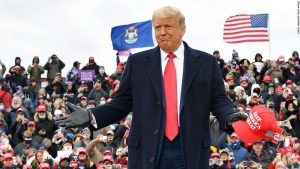NOVEMBER 2, 2020
Michigan auto jobs under Obama
In a Sunday tweet aimed at Michigan voters, Trump claimed that at the time he became president, the state “was hemorrhaging car companies and jobs.”
Facts First: It’s not true that Michigan was hemorrhaging auto jobs during Barack Obama’s presidency. In fact, between Obama’s first full month in office, February 2009, and Obama’s last full month in office, December 2016, Michigan added 11,700 vehicle manufacturing jobs and 45,300 auto parts manufacturing jobs. The number of parts manufacturing jobs in the state rose steadily, gaining every year of the Obama presidency, while the number of vehicle manufacturing jobs grew consistently from 2009 through 2014, then leveled off in Obama’s last two years.
In addition, there has not been a renaissance in Michigan auto manufacturing jobs since Trump took office. Even before the coronavirus pandemic temporarily caused auto employment to plummet in early 2020, Michigan had actually lost vehicle manufacturing jobs under Trump.
There were 40,300 vehicle manufacturing jobs in Michigan as of February 2020 — down 2,100 jobs from February 2017, Trump’s first full month in office. The most recent figure, a preliminary number for September 2020, is 37,600 vehicle manufacturing jobs in Michigan, down 4,800 jobs from February 2017.
The number of auto parts manufacturing jobs was essentially flat under Trump until the pandemic. There were 131,500 such jobs in Michigan as of February 2020, up just 100 jobs from February 2017. The September 2020 figure was 118,400 auto parts manufacturing jobs in Michigan, a decline of 13,000 from February 2017.
Kristin Dziczek, the vice president of industry, labor and economics at the Michigan-based Center for Automotive Research, said that employment in both vehicle and parts manufacturing in Michigan saw a “steady growth trend” that started in mid-2009 — that’s the first year of Obama’s administration — and continued until early 2015 for vehicles and early 2019 for parts.
Michigan auto plants under Obama
Trump claimed at the rally: “You didn’t have any auto plants four years ago.”
Facts First: This is obviously false. Michigan, which has made cars for more than a century, never stopped having auto plants under Obama. There were 13 car or truck assembly plants in Michigan in December 2016, the last full month of the Obama presidency, according to an Automotive News plant directory — and there were still 13 such plants in Michigan in October 2020, according to the publication’s directory from last month.
Japan and Michigan auto plants
At the Macomb County rally, Trump repeated his familiar story about how he supposedly pressured Japan’s then-prime minister, Shinzo Abe, into getting five Japanese companies to announce “the next day” that they were “moving to Michigan.”
(Trump didn’t say explicitly this time that the five companies were auto companies, but he had just been talking about the auto industry, and he has identified them as auto companies in previous versions of the story.)
Facts First: We have no idea what Trump and Abe might have said to each other in private, but the dramatic conclusion of the story isn’t true: there was no single day during Trump’s presidency on which five Japanese auto companies announced they were moving to the US, let alone to Michigan in particular.
Toyota did make a 2019 announcement that it was investing $749 million in its operations in five states, but that is one company, and Michigan was not one of the states. Dziczek identified five Michigan investments by Japanese automakers under Trump, but she said none is an auto assembly plant — previous versions of Trump’s story have involved the Japanese companies announcing “five plants” — and only one is a manufacturing facility at all.
That $85 million manufacturing investment, announced less than two weeks into Trump’s presidency in 2017, is a joint venture between General Motors and Honda to produce hydrogen fuel cell systems in an existing GM plant. The fuel cell initiative was expected to create “nearly 100” jobs, GM said in 2017; Dziczek noted that “an auto assembly plant generally employs roughly 2,000 a shift.”
The history of auto plants in Michigan
Trump said at the Macomb County rally, “No new plants had been built in Michigan in decades and decades before I got here.” At a Pennsylvania rally last week, he claimed it was “42 years” since an auto plant had been built in Michigan.
Facts First: Trump was wrong again. Dziczek noted that General Motors’ Lansing Delta Township assembly plant opened in 2006.
Plants under Trump
Trump claimed on Twitter that, under him, “many plants are and have been built.”
Facts First: Trump was exaggerating. During his presidency, there have been three total announcements of new auto assembly plants in Michigan — one of them a major facility, to be opened by Fiat Chrysler Automobiles, and two of them small by auto-plant standards.
Fiat Chrysler announced that it would invest $1.6 billion to modify an idled Detroit engine factory into an assembly plant making the Jeep Grand Cherokee and a new SUV, creating an estimated 3,850 jobs.
Waymo, a subsidiary of Alphabet Inc., said it would invest about $14 million to retrofit a Detroit plant to produce self-driving vehicles. Navya, a French company that makes self-driving buses, opened a small plant it said in 2018 employed 25 people.
There have been major automaker investments in existing Michigan plants as well. But Trump was stretching the truth when he suggested there have been a large number of new plants built during his tenure.
A dead industry?
During a “tele-rally” with Michigan residents earlier in October, Trump said, “The last administration killed the US auto industry. I saved the auto industry, I brought it back. The auto industry in this country was dead.”
Facts First: As we have shown above, the auto industry was clearly not anywhere close to “dead” when Trump took office — but it’s worth noting that the claim that the Obama administration “killed” the industry is an especially egregious inversion of reality. The Obama administration, along with the George W. Bush administration, helped rescue the industry with a federal bailout during the economic crisis of 2008 and 2009.
Courtesy/Source: CNN











































































































